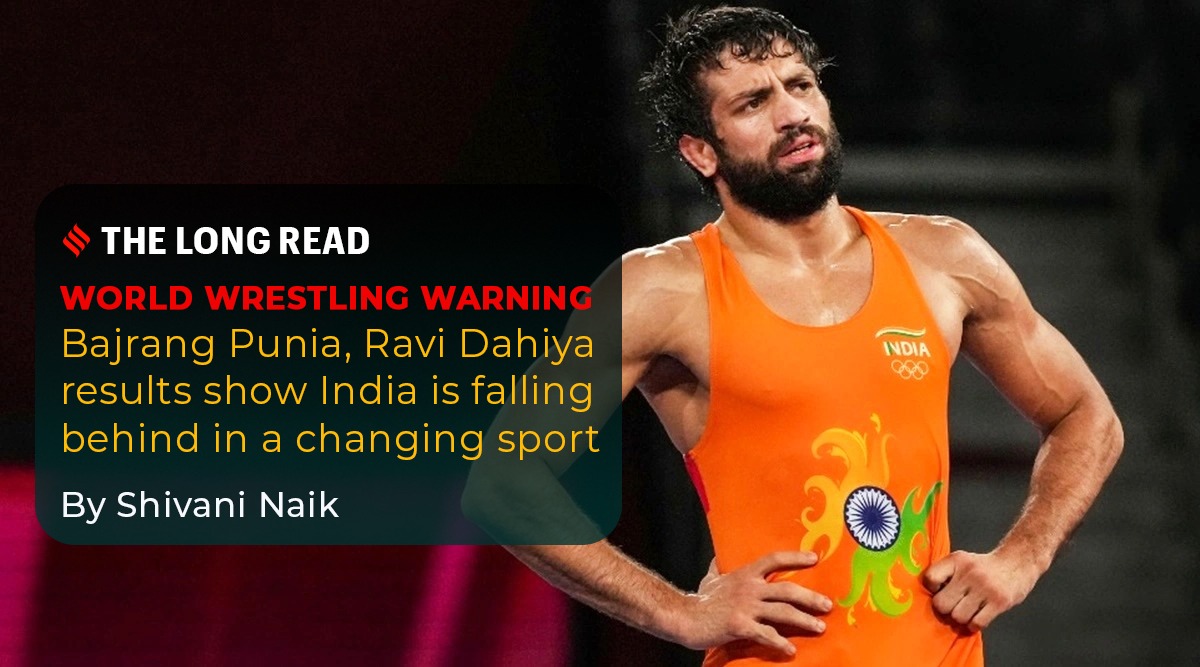 Ravi Dahiya's 10-0 loss to Uzbekistan's Gulomjon Abdullaev Should be a wake up call. (FILE/AP)
Ravi Dahiya's 10-0 loss to Uzbekistan's Gulomjon Abdullaev Should be a wake up call. (FILE/AP)Like a wrinkled weatherman that pithily drills in home truths about an incoming storm, letting his sobering bass voice rise just over the constant crackling of a fax machine in a remote observatory, India’s wrestling doyen Mahabali Satpal issues a warning: “US mazboot hoke aayaa hai iss World Championship mein [A strong US has come to this World Championship].” The seasoned wrestling coach, an ace schemer, medal-hunter par excellence of the last decade who triggered a wrestling renaissance with Sushil Kumar – still India’s only World Champion from a dozen years ago – is referring to USA’s 4 gold, 4 silver out of the 10 men’s freestyle categories available.
On a roll at the Stark Arena in Belgrade, perhaps aided by Russian absence and Japanese reticence to risk injuries, the Americans were relentless at the Worlds, topping the tally, while also cornering 3 gold and 2 silver in the women’s sections.
Satpal’s observation wasn’t merely the obvious stating of this staggering dominance. Starkly aware of the missing Russians and more importantly of how the chances of a gold will get steeper in the 2023 World Championship edition, he was mulling over the lost opportunity in a quieter year; next year with Paris Games quotas at stake, a title will be doubly harder to nail. His heroically mangled grappling ears were pricked with creeping desperation of what all needs to be done in the next two years. “Paris will be here in no time. We have to start planning now,” he said with urgency that’s second nature to someone who plotted India’s 2008 and 2012 medals.
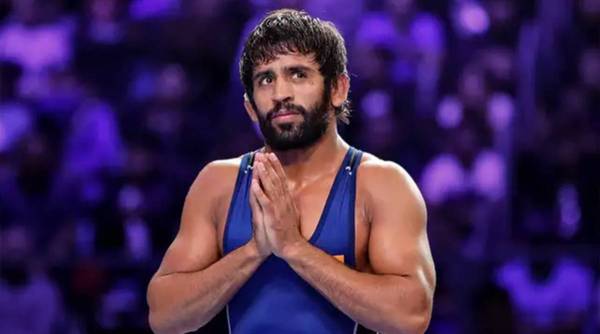 India will need to reboot their system to align with American standards, even if they can’t cart in the personnel. (Bajrang Punia. Bajrang Punia in photo/file.
India will need to reboot their system to align with American standards, even if they can’t cart in the personnel. (Bajrang Punia. Bajrang Punia in photo/file. The Bajrang Punia bronze deserved to be feted and then folded away in service of planning the future. And Ravi Dahiya’s no-medal needed a return to the drawing board, plus the younger bunch like Naveen in 74 kg needed fast-tracked propulsion, Satpal noted.
There aren’t too many veterans in India who will dare utter it publicly, because foreign coaches are seen as a cultural hoo-ha, and as an affront to India’s homegrown wisdoms. But the very practical – and frankly not too revolutionary – idea of getting in American coaching expertise is looming on an inevitable horizon. Russian (and thereabouts) coaches have always been viewed as crafty, and Indians value their technical nous and ability to stay in the background and not hog credit, which crucially costs a fraction of what an American pro would come for.
System reboot
But for that slap-shaping, brutally blunt professionalism – which can ensure two of the finest wrestlers of this decade, Bajrang and Ravi, do not fade away, like they almost did at the Belgrade Worlds – India will need to reboot their system to align with American standards, even if they can’t cart in the personnel.
It’s not just the medals that the western powerhouse monopolised, it is the entire wrestling ethos that is rapidly undergoing a fundamental change: global freestyle wrestling is thirsting for wins that come from eye-catching technical moves. The Indian reliance on wearing out opponents, outlasting them on stamina, building gas tanks to expend energy by bullying and battering. Globally, that style has made way for speedier, snappier, cleverer technical wrestling.
It’s why if you looked past Bajrang’s headline-hogging strapped head and focussed on the other extremity — just how cannily American Yianni Diakomihalis turned the Indian’s legs to jelly, three years after thumping him, imposing a tech superiority this time, you would know how far the American program has come along. And why Indians run the risk of falling back if they don’t jolt awake from this Commonwealth Games contentment and junior medals-induced lethargic limbo, while the seniors results at Worlds were frankly a howler. Yianni has the legend Kyle Drake on his training group, as the juggernaut gets oiled for a Paris run. Bajrang – before rallying to his bronze – himself would be well aware of the American stomp, having trained there.
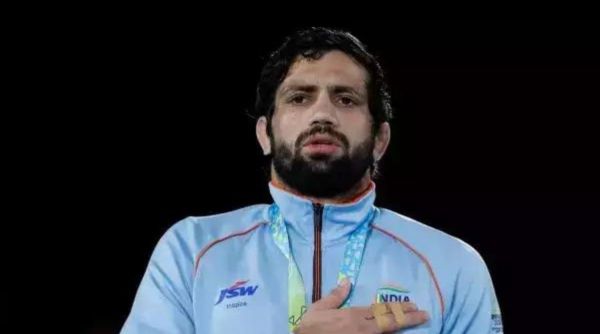 India’s Ravi Kumar Dahiya who competes in Men’s Freestyle 57 kg. (Reuters)
India’s Ravi Kumar Dahiya who competes in Men’s Freestyle 57 kg. (Reuters) He noted a few differences in how the two prepared. “Their training is aligned with competition times. They’ll train at 10am if the competition is to start at 10.30. They simulate rest period upto 4pm. Like here, we just train at 6am out of habit. They prepare for smaller rest periods. If the weather is expected to change, or food is going to be different, they train keeping those things in mind. Sparring partners are better and you get to know their style and about how particular players fight. American style is different.”
The typical Indian response to Ravi’s 10-0 loss in Round 2, will be calls for “aur zyada mehnat.” More hard work cooped up at the akhada. When what he might need most guidance in, is how to switch off or relax after the rough Worlds setback, and how to plan an offseason. Professionalism in planning that offseason work, in mapping out the next season and maintaining emotional balance is the sort of fresh thinking foreign coaches, always viewed with suspicion and scorn, can bring into this slightly stilted sport.
American Andrew Cook, a former women’s coach, was shunted out with such cold apathy, he remains heartbroken and totally befuddled by why a system would not buy into progressive professional ideas. But Indians tend to set a lot of store by junior results, deceive themselves by overlooking age-fraud that bulges these results, and as a result stay stagnant with Indian coaching methods, refusing to check their reality when near-routs like the senior Worlds (just two bronzes) happen. That a transition to seniors successes at the top-most level is simply not happening, is papered over.
The Ravi rattle
There is consensus that Ravi Dahiya had one bad off day when he could not stave off the attack from Gulomjon Abdullaev, conceded a series of 2-pointers, allowed tremendous pressure to build and couldn’t get a word in – that is, apply his own offensive technique. There is no clarity, however, on guaranteeing how a similar “bad off day” won’t derail him yet again as he looks to qualify for Paris, and then look for a gold there.
Far too talented to be passed over for the next-big-hope, the Tokyo silver medallist does have consistency issues, compounded by weight cut woes in 57kg. Weight cuts can get pretty brutal for the Big man amongst the Smalls.
Former Arjuna awardee and now commentator, Kripashankar Bishnoi, highlights the struggle, saying the 10-0 loss wasn’t a narrow pipping of “unneesa over beesa,” a 19 nosing ahead of a 20. Though Ravi is far too good a wrestler to not find a way around it. “His training can go up and down, because his weight cuts are massive. So peaking for CWG, reducing weight, then going back to build strength and stamina, then again a cut. This can affect oxygen supply to the brain on bout days, and hamper speed of the body even if mind is pushing through with a move. Muscles go weak, coordination suffers, major injuries can happen in these extreme weight fluctuations and make you psychologically weak.”
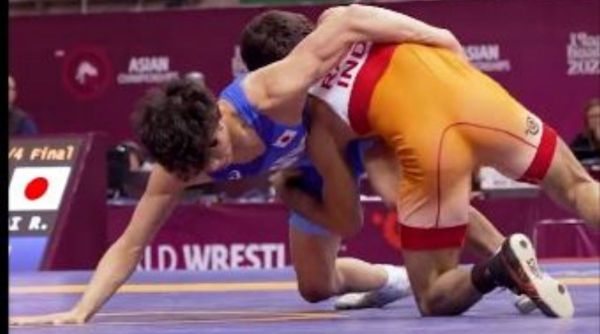 Ravi Dahiya in action. (Videograb)
Ravi Dahiya in action. (Videograb) A big fan of Ravi’s bagal doob, Bishnoi reckons weight cuts are cramping his style and ability as muscles go loose with dehydration, and he needs serious coaching and diet interventions to save him from this recurrence.
There are other aspects his opponents exploit technically. Taller for his weight division, when opponents go really low-slung, his feet-apart stance, while lending stability, can seem too cramped to spring up, and vulnerable to sweeping leg attacks. He makes his longer hand reach count, applying the swinging arms to gut wrenches and other pick and falls. But he was strangely static against the Uzbek, late on his counters as his reaction speed seemed considerably slower when opponents would shoot for his leg.
It’s the Uzbek’s third win against Ravi in five meetings, and he has hoarded points going for single leg attacks, creating pressure, nullifying Ravi’s locks careening towards stalemates, as points pile up in twos with the pressure mounting. In the second period, by the time Ravi’s hands responded to the duck-unders, his leg had been breached, and was putty in point-chomping hands. A closer compact hand stance, dipping the hips lower, might ward off these attacks that ram into his legs straight. Or there’s the half dozen stepouts. But the Indian has built himself a nice little nemesis since his junior days, who doesn’t pass on the repechage benefits either, and is felled himself before the finals.
That Abdullaev posed a problem was well known. That Ravi wouldn’t be able to drag it to the death seconds, was a surprise.
The Bajrang boggle
The bulk of it is to do with the torpedoed knee, but Bajrang’s leg defense has been hoisting wincing posers. He always got entangled on ground attacks, but it was a shade of overconfidence that caused his downfall against the American, who he could easily beat three years ago.
On the whole, Bajrang is only amping his aggression, hoping the power barrel keeps firing for all six minutes. He puts in the same amount of hard work now that he did five years ago, and that might not be the smartest call for his body, which needs to conserve speed bursts for a more relaxed 2-1 win, instead of powering on for 11-9s each time. Smarter pacing of bouts will demand better defense, and his leg defense isn’t always coping. Against faster, craftier opponents, with better defense, he might not be able to pull off those rallies, which he heroically did at Belgrade for a stunning 4th medal, hinging on brute power along the arc.
 Bajrang Punia has been doing a range of exercises to build strength. (Source: bajrangpunia60/Instagram)
Bajrang Punia has been doing a range of exercises to build strength. (Source: bajrangpunia60/Instagram) Like most Indian wrestlers raised on mud, the migration to mat lugged around a manufacturing defect: because you can wait forever on mud (some dangals go on for 2-3 hours) and take own sweet time to gauge opponents, before applying technique, you lean on the crunching, pummelling powergame much more than speed and agility. No chit & pat.
“Mud bouts have a lot of standing grappling, so ground attacks aren’t intrinsic and smaller muscles aren’t worked enough. Yet, Bajrang always kept opponents at bay, and moreover, countered with speed and strength earlier,” Bishnoi explains.
Sushil Kumar was built stocky, short and speedy. He could crouch low like a tiger, and use his strength to cling to the mat flat on his belly, without ceding points on phitle or waist holds. That speed and cleverness to go with the stance made his leg elusive, something that wasn’t seen in the week of weak leg defenses.
Americans do a lot of speed workouts, shuttle runs – something an Indian wrestler might be loathe to do, even as wrestling gets more agile by the day, and quick-reflexed.
Coaching stuck
Closely tied in with this inability to buy into scientific training is the casual manner in which support staff like physio and masseuse are not treated as non-negotiable. Even coaching choices come in for a sharp lashing from Bishnoi, who says he’s frustrated with the unchanging, crusty old ways.
“I doubt if proper video analysis even happens at elite levels. We still have coaches who are excellent wardens, but not the best as coaches. Wrestling is traditional and revered in India. But almost every country traces back the sport in its history, so India’s not uniquely special. Bajrang’s bronze is commendable because this is a global sport. Which means all top countries are progressing fast and investing in upgrading training. We should too,” he urges.
Bishnoi was particularly pained watching a senior coach hold the washroom door aloft for a senior federation official, and says coaches should be appointed on capabilities, not for kowtowing. While international exposure trips have increased for Indians, the coaching expertise remains warped.
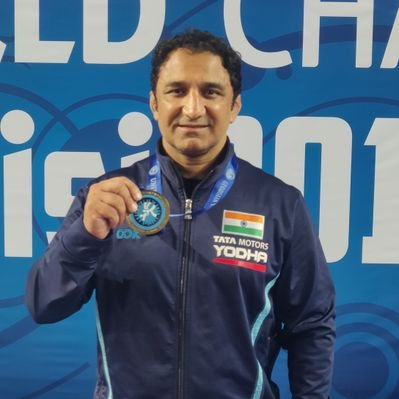 Former Arjuna awardee and now commentator, Kripashankar Bishnoi.
Former Arjuna awardee and now commentator, Kripashankar Bishnoi. Bajrang and Deepak Punia’s earliest coach Virender says the gap is widening. “In India you return with a medal, and spend months playing a hero as the dhols don’t stop drumming up. In other top countries, they’ll return and start planning for the next big tournament the day after. And we don’t use video analysis enough.”
Another pressing reason why foreign coaches might be necessary is because Indian coaches are wary of cracking whips on medalling wrestlers, given how the reverence balloons into this unequal equation with the badaa pehlwaan. Indian coaches haven’t warmed up to working alongside foreigners either to learn the latest training methods.
The horror planning which saw CWG, trials and Worlds being stashed into six weeks will continue with no awareness of the science of peak performance. Trials often used arbitrarily to show wrestlers their place, or unleash a junior edgewise against a senior, lack transparency of intent. Wrestlers prefer being individualistic, not trusting the system to play fair, and no cogent team ethos has developed.
Satpal recalls his food and weather recce of Beijing and London and minute planning that brought home the early medals. Having lost his medal chances at Munich and Moscow, felled by food (“aaloo ni khaaya jaata tha oil ki vajah se, aur 10kg milk daily ki aadat thi. Wo koun samhaalta? [I couldn’t have potatoes because of the oil, and was used to 10kg milk daily. Who would’ve taken care of that?”), he ensured Sushil & Co didn’t suffer. “We have to be attentive to temperatures outside the hall, and inside. Food has to be comforting,” he adds of the detailing.
Stating that Ravi would’ve been studied thoroughly by now, he stresses on greater need for video analysis. “First we need people who will analyse, and then coaches who can employ those insights,” he says, recalling his primitive stab at it, with extensive jottings in his diary back in 2008.
While the Worlds (possibly at Budapest) will be the straightforward target for Indian wrestlers next year serving as qualifying for Paris, the runup to that promises a lot of drama. If the ceremony of trials overshadows the wrestling itself, it could be another World Championship with shocking results like this year. It’s too early to panic, but it could get too late to plan, if 2022 is allowed to dawdle into 2023.